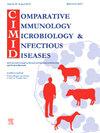Efficacy of a high dose of isometamidium chloride treatment in single and mixed experimental infections with T. congolense and T. brucei brucei in dogs
IF 2
3区 农林科学
Q4 IMMUNOLOGY
Comparative Immunology Microbiology and Infectious Diseases
Pub Date : 2025-01-22
DOI:10.1016/j.cimid.2025.102303
引用次数: 0
Abstract
Canine African trypanosomosis is endemic in sub-Saharan Africa. Chemotherapy remains the commonly employed approach to trypanosomosis control. However, it is beleaguered by the absence of new drugs, treatment failures, relapse infection and resistance. The efficacy of a high dose of isometamidium chloride (ISM) in single and mixed infections of T. congolense and T. brucei brucei therapy was assessed in dogs. Fifteen dogs employed in this study were allocated into four groups at random, each with four dogs except group I which had three dogs. Group I dogs were not infected while groups II and III dogs received 106 T. congolense and T. brucei brucei respectively. Group IV dogs received both (5 × 105) T. congolense and T. brucei brucei. Groups II-IV dogs were dosed with 1 mg/kg ISM (Trypamidium-Samorin®) intraperitoneally on day 14 post-infection (PI). Parasitaemia levels, live body weight changes (LBWC), clinical signs, rectal temperature (RT), some haematological and serum biochemical parameters were used to evaluate the efficacy of high dose of ISM. Following infection, all the infected dogs became parasitaemic by the 14th day PI, with obvious clinical signs. Treatment with ISM cleared parasitaemia within 72 hours post-treatment, caused the reversal of the clinical signs, and enhanced the RT, LBWC, haematological and serum biochemical parameters of the dogs. Relapse infection was not recorded throughout the study duration (84 days post-infection). In conclusion, 1 mg/kg of ISM is effective in treating African trypanosomosis in dogs and should be adopted as a first-line treatment for the disease.
大剂量异异胺氯治疗犬单次和混合实验性刚果体和布氏体感染的疗效观察。
非洲犬锥虫病是撒哈拉以南非洲的地方病。化疗仍然是控制锥虫病的常用方法。然而,它受到新药缺乏、治疗失败、复发感染和耐药性的困扰。研究了高剂量异甲基氯胺(ISM)治疗刚果体和布氏体单一感染和混合感染的疗效。本研究使用的15只狗随机分为四组,除了第一组有三只狗外,每组有四只狗。ⅰ组犬未感染,ⅱ组和ⅲ组犬接种106T。分别是刚果和布氏绦虫。IV组犬同时感染刚果弓形虫和布氏弓形虫(5 × 105)。II-IV组于感染后第14天腹腔注射1 mg/kg ISM (Trypamidium-Samorin®)。采用寄生虫血症水平、活体重变化(LBWC)、临床体征、直肠温度(RT)及部分血液学和血清生化指标评价高剂量ISM的疗效。感染后第14天,所有感染犬均出现寄生虫病,临床症状明显。ISM治疗后72 小时内清除了寄生虫血症,使临床症状逆转,提高了犬的RT、LBWC、血液学和血清生化指标。在整个研究期间(感染后84天)未记录复发感染。综上所述,1 mg/kg的ISM治疗犬非洲锥虫病是有效的,应作为该病的一线治疗方法。
本文章由计算机程序翻译,如有差异,请以英文原文为准。
求助全文
约1分钟内获得全文
求助全文
来源期刊
CiteScore
4.60
自引率
0.00%
发文量
102
审稿时长
40 days
期刊介绍:
Comparative Immunology, Microbiology & Infectious Diseases aims to respond to the concept of "One Medicine" and to provide a venue for scientific exchange. Based on the concept of "Comparative Medicine" interdisciplinary cooperation between specialists in human and animal medicine is of mutual interest and benefit. Therefore, there is need to combine the respective interest of physicians, veterinarians and other health professionals for comparative studies relevant to either human or animal medicine .
The journal is open to subjects of common interest related to the immunology, immunopathology, microbiology, parasitology and epidemiology of human and animal infectious diseases, especially zoonotic infections, and animal models of human infectious diseases. The role of environmental factors in disease emergence is emphasized. CIMID is mainly focusing on applied veterinary and human medicine rather than on fundamental experimental research.

 求助内容:
求助内容: 应助结果提醒方式:
应助结果提醒方式:


